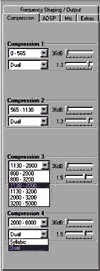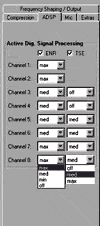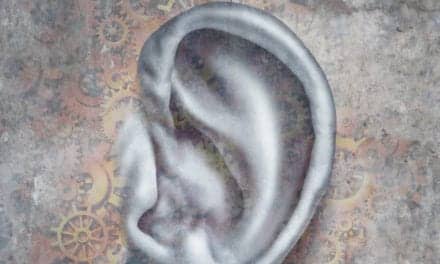The components of music shed light on important aspects of hearing perception.
To make music, musicians must be able to produce and keep track of subtle changes that occur along numerous dimensions of sound, often unfolding in parallel over time. To understand music, listeners must be able to perceive and make sense of these subtle changes.
The opportunities for masking in music abound, and compared with speech, the range of pitch and intensity levels can vary dramatically. Musical tones include important energy components infringing on both the lower and upper pitch limit. For example, the fundamental frequency of low piano tones fall below 20 Hz, and the upper partials of violin tones rise above 20,000 Hz. In addition, the difference between peak intensity and average intensity is considerably higher in music than it is in speech.1,2 This additional variability amounts to a formidable challenge for any auditory system—let alone one that is impaired in some manner.
Fortunately, however, the affective experience of music does not depend on veridical perception of any one dimension, and is heavily influenced by long-term memory and schemas. For example, a particularly important pitch can be indicated by an increase in loudness, vibrato, and duration, as well as expectancy generated by the sequence of preceding pitches. In addition, affective aspects of music tend to be over-determined with convergent cues from multiple dimensions. Thus, reduced sensitivity to a particular dimension of music will not necessarily lead to a gross distortion in music perception, and will almost never lead to a music experience devoid of affective possibilities. Indeed it is uncommon for people with acquired hearing loss to turn off music completely.
Nonetheless, individuals with acquired hearing loss are often aware, on some level, of reduced sensitivity to particular dimensions of music. In the case of professional musicians, audiophiles, or dedicated music lovers, this reduced sensitivity may be particularly troubling.
What follows is a selective overview of perceptual dimensions contributing to music experience that may have implications for the treatment and research of hearing loss. The overview is by no means exhaustive, and focuses mainly on my own work and the work of my colleagues (experimental psychologists working in the field of music perception and cognition) on issues pertaining to relative pitch. In some cases, direct recommendations are made, but more often, informed speculation is offered in the hopes of seeding future research.
Fundamentals of Relative Pitch
Pitch is often described as the perceptual correlate of fundamental frequency, but other dimensions such as timbre and loudness are also known to influence pitch. Sensitivity to relations between pitches, called relative pitch, is essential to the music experience and is the basis of the concept of a musical interval. A musical interval is created when two tones are sounded sequentially or simultaneously. Sequential intervals form the basis of melody, and simultaneous intervals form the basis of harmony.
Although most important pitch relations concern adjacent pitches, in hierarchically structured music, relations between non-adjacent pitches are also important. Most popular music possesses a tonal framework, in which the stability of pitches is specified with reference to the tonic pitch or key-note of a piece.
Melodic Pitch Relations, Timbre, and Amplification
Timbre is a non-pitch variable that is based on an amalgam of physical changes, including changes to the frequency spectrum, phase spectrum, and the intensity of a sound. People are most aware of timbre when trying to identify a sound source or when trying to stream apart the independent lines of a polyphonic piece.3 Obviously, disruptions in the perception of timbre can have direct consequences for instrument identification and streaming. Somewhat less obvious is the idea that disruptions in the perception of timbre may have consequences for the experience of relative pitch.
Research has shown that, if a rising pitch contour involves a transition from a dull tone to a bright tone, the perceived distance will be expanded; if it involves a transition from a bright to dull tone, the perceived pitch distance will be contracted.4 The converse is true for falling pitch contours. It’s quite possible that listeners with selective hearing loss experience these sorts of relative pitch distortions when listening to melody—regardless of whether or not timbre is actually changing. These relative pitch distortions may have aesthetic consequences.

Imagine, for example, a listener with high-frequency hearing loss listening to a typical melody that starts at some medium pitch level, rises to build tension, and then resolves itself by returning to the starting pitch (see the stylized representation in Figure 1). If the rise in pitch encroaches on the upper limit of the listener’s available frequency range, the upper partials will fall out of range, and as a result timbre will be perceived as duller. As mentioned, when pitch is rising, moving from a bright to dull timbre has the effect of compressing perception of interval size. This compression of interval size may minimize the build up of tension in the melody, and in turn, lessen the experience of resolution at its end.
As Marshall Chasin, myself, and others have noted, music listeners with high-frequency hearing loss may experience some benefit by transposing recorded music into lower registers. For digitized music, transpositions can be realized quite easily using widely available commercial software (eg, CoolEdit, Protools, Melodyne), though at present, artifacts become manifest beyond about a half-octave transposition.
For those with access to MIDI music, transpositions can be made without artifact, regardless of the extent of transposition. However, it should be noted that transposition does alter the experience of relative pitch to some extent. For example, lower transpositions of an interval tend to be experienced as somewhat smaller than higher transpositions.5
Harmonic Pitch Relations and Reduced Frequency Selectivity
“A triad below middle C sounds to me completely out of tune. Orchestral sounds are even worse: Low pitch, varying harmonics, and frequent key changes don’t help.”
— J.M., personal correspondence, 2005, Norwich, England
J.M. is a retired scientist and life-long musician with profound hearing loss acquired relatively late in life. He recently purchased a set of new high-end digital hearing aids and continues to listen to music despite the fact that familiar combinations of pitches no longer sound the way he remembers. Reduced frequency selectivity is likely the culprit. It is unknown whether digital processing techniques for combating effects of reduced frequency selectivity on speech, such as spectral enhancement,6,7 may also benefit music. However, a host of other simple interventions presently exist.
With recorded music, presentation by headphone will preserve phase relationships, which can contribute to relative pitch perception.8 Accurate fine-grained temporal relationships may be very important for perceiving music,9 particularly in the case of a listener with reduced frequency selectivity. With live music, FM systems may also be of some benefit. An optimally placed microphone can compensate for numerous problems including sensitivity to noise, high-frequency losses, as well as reduced frequency selectivity.
Finally, simply seeing the music may provide assistance. There is increasing evidence showing that people can see musical structure from various visual cues such as facial expressions and gestures (eg, the musical equivalent of lip reading). In addition, these visual cues can actually modify the auditory experience.10 For example, visual cues can make a dissonant chord sound more consonant.
Hierarchical Pitch Structure, Intensity Variation, and Compression
Periodic variations in intensity create a temporal framework (rhythm) that supports representations of relative pitch in music.11 Generally speaking, when variations in intensity are weak or non-existent (isochronous), we are left with a relatively shapeless piece of music, without any clear hierarchical structure.
The use of compression in hearing aids is particularly important for the music signal given its inherently wide dynamic range. However, the overuse of compression may have the effect of minimizing intensity differences, leaving important pitch relationships less apparent. It would be interesting to test sensitivity to hierarchical structure in music in the presence of varying levels of compression. Other important issues to consider with compression include the subjective assessment of a clear rhythm or pulse.
Tonality, Inharmonicity, and Presbycusis
Tonality refers to the hierarchical organization of pitches around the tonic or key-note of a piece. In Western music, this organization has been described as a four-level hierarchy of stability. The highest stability is assigned to the tonic tone (do), followed by non-tonic triad tones (mi, sol), followed by non-triadic tones (re, fa, la, ti), and finally the non-scale tones. Pitches that occupy more stable positions in the hierarchy are more likely to start and end a piece and to occur more often.
A method called the probe-tone technique allows for the assessment of the psychological representation of tonality.12,13 Using this method, my colleagues and I have found that most listeners are sensitive to the hierarchy of pitches implied by a pitch sequence.14 This is not surprising—even the most tin-eared amongst us can detect when someone practicing the piano has hit a wrong note.
However, we have found that minor perturbations in the fine temporal structure of tones (eg, inharmonicity or aperiodicity) can lead to a significant loss in ability to recover the tonal hierarchy.14 (These findings have been corroborated by Russo, Cuddy, Galembo, and Thompson, paper under review, 2006.) These perturbations are introduced naturally in tones produced by stringed instruments due to deviations from ideal elasticity.
Similar perturbations may be introduced by a hearing aid, or by an impaired auditory system.15 Future research could systematically assess the influence of temporal asynchronies on tonality perception by utilizing the probe-tone method. Assessments could be made with young normal-hearing individuals listening to music that has been temporally perturbed to varying degrees. Practical interventions suggested above for improving perception of harmony may have similar benefits for perception of tonality.
Summary
More research is needed that will provide direct evidence concerning the effects of hearing loss on the perception of music. Results of future experiments will contribute to knowledge of the specific auditory deficits that reduce the everyday listening experiences of hearing-impaired listeners and will provide a template for designing and fitting hearing assistive devices (eg, pre-amps, digital processing algorithms, FM systems).
Given the importance of music in modern media and society in general, these questions represent an overlooked but important direction for hearing research.

|
Correspondence can be addressed to HR or Frank A. Russo, PhD, Department of Psychology, University of Toronto at Mississauga, Mississauga, ON, L5L 1C6, Canada. Web site: www.utm.utoronto.ca/~frusso; email: [email protected].
References
1. Chasin M. Music and hearing aids. Hear Jour. 2003;56(7):36-41.
2. Chasin M, Russo FA. Hearing aids and music. Trends in Amplif. 2004;8:35-47.
3. Bregman AS. Auditory Scene Analysis. Cambridge, MA: MIT Press; 1990.
4. Russo FA, Thompson WF. An interval-size illusion: The influence of timbre on the perceived size of melodic intervals. Perception & Psychophysics. 2005;67:559-568.
5. Russo FA, Thompson WF. The subjective size of melodic intervals over a two-octave range. Psychonomic Bulletin & Rev. 2005;12:1068-1075.
6. Moore BCJ. Perceptual Consequences of Cochlear Damage. London: Oxford University Press; 1995.
7. Moore BCJ. Speech processing for the hearing-impaired: Successes, failures, and implications for speech mechanisms. Speech Communication. 2003;41:81-91.
8. Galembo A, Askenfelt A, Cuddy LL, Russo FA. Effects of relative phases on pitch and timbre in the piano bass range. J Acoust Soc Amer. 2001;110:1649-1666.
9. Attneave F, Olson RK. Pitch as a medium: A new approach to psychophysical scaling. Amer Jour Psychol. 1971;84:147-166.
10. Thompson WF, Graham P, Russo FA. Seeing music performance: Visual influences on perception and experience. Semiotica. 2005;156,203-227.
11. Jones MR, Boltz M. Dynamic attending and responses to time. Psychol Review. 1989;96:459-491.
12. Krumhansl CL, Shepard RN. Quantification of the hierarchy of tonal functions within a diatonic context. J Experimental Psychol: Human Perception and Performance. 1979;5:579-594.
13. Thompson WF, Cuddy LL. Music performance and the perception of key. J Experimental Psychol: Human Perception and Performance. 1997;23,116-135.
14. Russo FA, Galembo A, Cuddy LL. Evaluation of perceived tonality across the musical pitch range. Canadian Acoustics. 1997;25:35.
15. Schneider BA, Pichora-Fuller MK. Age-related changes in temporal processing: Implications for speech perception. Sem in Hearing. 2001;22:227-239.




